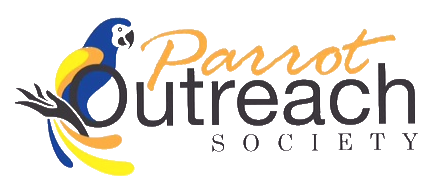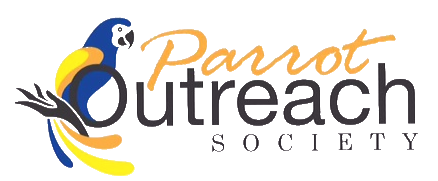WING CLIPPING:
A properly clipped parrot should glide gracefully to the floor and have enough feathers to break it’s fall. If too many feathers are clipped, injuries to the keel bone, leg fractures and worse can occur. Preventing upward and rapid flight is the main purpose of clipping wings, not to make the bird flightless. When performed properly wing clipping is a safe procedure. Larger parrots typically require fewer feathers to be clipped than smaller birds.
Baby parrots whose wings are clipped before learning to fly may never develope take off and landing skills.This lack of take off and landing skills can contribute to loss of development of balance, grace and agility. These parrots may never fly.
Wing clipping is best left to Vets or experienced bird handlers. Primary coverts, secondary feathers and secondary coverts should never be clipped.
A competent assistant with knowledge of proper restraint is a must. The chest must not be restructed, it will impede breathing. The opposite wing should be restrained. The bird should be gently wrapped in a towel and held by encircling the neck with the thimb and forefinger under the lower jaw. The wing to be clipped should be held at the base of the humerus, not by the feathers. You should be looking down on the the top of the wing. The under side of the wing should be checked for the presence of blood feathers. If blood feathers are present, clipping should be delayed. Each feather should be isolated then grasped by the clippers and cut at the same time, ensuring the overlaying primary covert feathers are not cut. Animal claw clippers should be used, not scissors as their point can injure the bird. Remove the first 4 primary feathers on each wing. After the intial clip the bird should be tested for flight to determine if more feathers need to be clipped. The bird should glide gracefully to the floor without lift or horizontal flight. Small birds usually require 8-10 primaries be clipped.
TOENAILS:
To check the length of your birds nails, set it on a flat surface. If the toe lifts off the surface the nail is too long.
Locating the quick of the nail can be done on pink or white nails as the blood supply is visible. Dark nails do not have visible blood supplies.
The bird should be gently toweled with feet the feet exposed. A dremel tool can be used for Conure to Macaw size birds. It provides for fast , safe nail trimming and allows the end of the nail to be rounded. Using a dremel also has the added benefit of cauterizing the naill if trimmed a bit too short. nails of all size birds can also be clipped at the tip with animal claw clippers taking just the point. With a very tolerate or young bird a human nail file can be used, no matter the size of the bird. If the nails are overgrown it is best to clip small amounts in a setting then allow the quick to dry up and clip again in a week, repeating this until the nails are of desirable length.
BEAKS:
Beaks should never be trimmed at home. This should be done by a professional Vet. beaks do not require routine trimming. If the birds beak is over grown, it requires Vet care. Some avian diseases can cause overgrown beak. Crooked beaks can also allow for overgrowth due to the beaks not matching up to provide normal wear. Beaks are very vascular and bleed badly when over trimmed. You also risk breaking the beak trying to trim it at home. Again this should be done by a Vet!



